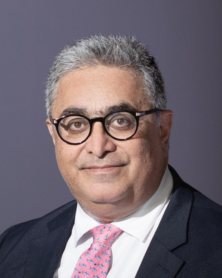Plenary Talks
We are honored and delighted to host the following IEEE ICIP 2024 Plenary Talks:
Reliable AI meets Image Processing
Professor Gitta Kutyniok
Ludwig-Maximilians-Universität München, Munich, Germany
Session chair: Aggelos Katsaggelos a-katsaggelos@northwestern.edu
The new wave of artificial intelligence is impacting industry, public life, and the sciences in an unprecedented manner. The area of image processing has been particularly impacted by AI-based approaches, which sometimes by far outperform classical approaches for particular problem classes. However, one current major drawback is the lack of reliability of such methodologies.
In this lecture we will first provide an introduction into this vibrant research area. We will then present some recent advances in image processing, focussing on optimal combinations of traditional model-based methods with AI-based approaches in the sense of true hybrid algorithms. Due to the importance of explainability for reliability, we will also touch upon this area by highlighting an approach which is itself reliable due to its mathematical foundation. Finally, we will discuss fundamental limitations of artificial intelligence on classical computing hardware, which seriously affect diverse aspects of reliability, and reveal a surprising connection to novel computing approaches such as neuromorphic computing and quantum computing.
Bio: Gitta Kutyniok currently holds a Bavarian AI Chair for Mathematical Foundations of Artificial Intelligence at the Ludwig-Maximilians-Universität München. She received her Diploma in Mathematics and Computer Science as well as her Ph.D. degree from the Universität Paderborn in Germany, and her Habilitation in Mathematics in 2006 at the Justus-Liebig Universität Gießen. From 2001 to 2008 she held visiting positions at several US institutions, including Princeton University, Stanford University, Yale University, Georgia Institute of Technology, and Washington University in St. Louis. In 2008, she became a full professor of mathematics at the Universität Osnabrück, and moved to Berlin three years later, where she held an Einstein Chair in the Institute of Mathematics at the Technische Universität Berlin and a courtesy appointment in the Department of Computer Science and Engineering until 2020. In addition, Gitta Kutyniok held an Adjunct Professorship in Machine Learning at the University of Tromso from 2019 until 2023. Gitta Kutyniok has received various awards for her research such as an award from the Universität Paderborn in 2003, the Research Prize of the Justus-Liebig Universität Gießen and a Heisenberg-Fellowship in 2006, and the von Kaven Prize by the DFG in 2007. She was invited as the Noether Lecturer at the ÖMG-DMV Congress in 2013, a plenary lecturer at the 8th European Congress of Mathematics (8ECM) in 2021, and the lecturer of the London Mathematical Society (LMS) Invited Lecture Series in 2022. She was also honored by invited lectures at both the International Congress of Mathematicians 2022 (ICM 2022) and the International Congress on Industrial and Applied Mathematics (ICIAM 2023). Moreover, she was elected as a member of the Berlin-Brandenburg Academy of Sciences and Humanities in 2017 and of the European Academy of Sciences in 2022 and became a SIAM Fellow in 2019 and an IEEE Fellow in 2024. She currently acts as LMU-Director of the Konrad Zuse School of Excellence in Reliable AI (relAI) in Munich, serves as Vice President-at-Large of SIAM, and is spokesperson of the DFG-Priority Program “Theoretical Foundations of Deep Learning” and of the AI-HUB@LMU, which is the interdisciplinary platform for research and teaching in AI and data science at LMU. Gitta Kutyniok’s research work covers, in particular, the areas of applied and computational harmonic analysis, artificial intelligence, compressed sensing, deep learning, imaging sciences, inverse problems, and applications to life sciences, robotics, and telecommunication.

Neuromorphic-based Brain-computer Interfaces to Recover Vital Functions: Algorithms, Signals, Images, and System-on-Chips.
Professor Mohamad Sawan
Westlake University, Hangzhou, China, and Emeritus Professor in Polytechnique Montreal, Canada
Session chair: Magdy Bayoumi magdy1112@yahoo.com
Neurodegenerative diseases require much more attention from both research groups and funding agencies. The need concerns not only to find out causes but to improve onset detection mechanisms, enough ahead of time before a disease can emerge. Refractory to conventional solutions such as medicine administration and/or surgical treatment, brain disorders require advanced microsystems based closed-loop neuromodulations. Intelligent medical devices built around neuromorphic brain-machine interfaces are intended for the diagnostic, treatment, and prediction of main neurodegenerative diseases. The machine learning methods are becoming most effective way to bring solution to such complex health conditions. This talk covers end-to-end brain-microsystem interfaces dealing with multidimensional software and hardware design and implementation challenges such as power harvesting, low-power building blocks, power management, massively parallel data acquisition, signal and image processing, high-data rate wireless bidirectional communication, integrated on chip application-specific system architectures including memristors, circuit and system techniques of artificial intelligence algorithms intended for various biomarkers detection, as well as for selective health conditions prediction. Special interests will be paid to various biosensors proposed to detect brain diseases at various molecular and neural cells levels. Case studies include tools to locate, detect, treat by electrical stimulation, and predict epileptic seizures, as well as addictions, vision, and Alzheimer. Also, recent research findings will be given to show work on neural cells and organoids culturing and manipulation, as well as neurotransmitters detection and corresponding link with specific diseases.
Bio: Mohamad Sawan is Chair Professor in Westlake University, Hangzhou, China, and Emeritus Professor in Polytechnique Montreal, Canada. He is the founder and director of the Center of Excellence in Biomedical Research on Advances-on-Chips Neurotechnologies (CenBRAIN Neurotech) in Westlake University, and of the Polystim Neurotech Lab in Polytechnique Montreal. He received his Ph.D. degree from the University of Sherbrooke, Canada. He served as a Distinguished Lecturer of both IEEE CASS and IEEE SSCS for three consecutive years each. Co-Founder, Associate Editor and was Editor-in-Chief of the IEEE Transactions on Biomedical Circuits and Systems (2016-2019). He was awarded the Canada Research Chair in Smart Medical Devices (2001-2015) and was leading the Microsystems Strategic Alliance of Quebec (ReSMiQ), Canada (1999-2018). Dr. Sawan published more than 1000 peer-reviewed journal and conference papers, one Handbook, three books, 13 book chapters, 15 patents, and 25 other patents are pending. He received several awards, among them the Barbara Turnbull Award from the Canadian Institutes of Health Research (CIHR), the J.A. Bombardier and Jacques-Rousseau Awards from the Canadian ACFAS, the Queen Elizabeth II Golden Jubilee Medal, the Medal of Merit from the President of Lebanon, the Chinese National Friendship Award, and the Shanghai International Collaboration Award. Dr. Sawan is a Fellow of the Royal Society of Sciences of Canada (FRSC), a Fellow of the Canadian Academy of Engineering (FCAE), a Fellow of the Engineering Institutes of Canada (FEIC), a Life Fellow of the IEEE (LFIEEE), and an “Officer” of the National Order of Quebec.

A new paradigm in AI-powered visual sensing and representation
Professor Touradj Ebrahimi
Ecole Polytechnique Fédérale de Lausanne, Lausanne, Switzerland
Session chair: Moncef Gabbouj, moncef.gabbouj@tuni.fi
Since the inception of electronic imaging, the acquisition, representation, and display of visual information have predominantly leveraged the spatiotemporal characteristics of the human visual system. While the digitization of images ushered in opportunities for more efficient data processing and analysis, leading to enhanced quality and appealing features in imaging systems, the fundamental models and workflows underlying the journey from image capture to display have remained largely unaltered. This status quo prevailed until recent times.
The burgeoning interest in machine learning, specifically deep neural networks, colloquially known as artificial intelligence (AI), which encompasses a broader conceptual framework, has delivered remarkable performance in a multitude of imaging applications when compared to traditional model-based approaches. Some AI methods have matured sufficiently to be incorporated into contemporary products and have even garnered consideration from international standardization committees seeking to define new specifications for the effective representation of visual information and exchange formats in both human-centric and machine-centric contexts.
A thought-provoking question that beckons the research community is: what lies ahead? Will the current AI-driven imaging paradigm endure for many more decades, or are there alternative approaches that may bring about another fundamental shift sooner than anticipated? This talk aims to delve into this inquiry.
We commence with a succinct examination of model-based image capture and representation, highlighting their merits and exposing their notable shortcomings. Subsequently, our focus shifts to the initial wave of AI-powered imaging systems, subjecting them to a similar analysis, elucidating their strengths vis-à-vis their predecessors, while also acknowledging their limitations.
In addition, we endeavor to delineate several observations on seemingly unrelated trends in the realm of visual information capture and synthesis, encompassing areas such as event-based vision and generative AI. These observations will serve as a foundation for outlining, through illustrative examples, the potential emergence of a second-generation AI-powered approach to visual sensing and representation. Some of these concepts are already being implemented in practical applications in rudimentary forms.
The talk culminates in an in-depth exploration of the advantages and challenges associated with this novel paradigm when juxtaposed with the state of the art.
Bio: Touradj Ebrahimi is professor of image processing at Ecole Polytechnique Fédérale de Lausanne (EPFL) and active in teaching and research in multimedia signal processing. He is the Director of Multimedia Signal Processing Group at EPFL. Since 2014, he has been the Convenor (Chairman) of the JPEG standardization Committee which has produced a family of standards that have revolutionised the world of imaging. He represents Switzerland as the head of its delegation to JTC1 (in charge of standardization of information technology in ISO and IEC), SC29 (the body overseeing JPEG and MPEG standardization) and is a member of ITU as the main representative of EPFL. Prof. Ebrahimi is also involved in Ecma International as a member of its ExeCom. He serves as consultant, evaluator and expert for European Commission and other governmental funding agencies in Europe and advises a number of Venture Capital companies in Switzerland in their scientific and technical audits. He has founded several startup and spinoff companies in the past two decades, including the most recent RayShaper SA, a research startup company based in Switzerland involved in AI powered multimedia. His areas of interest include image and video compression, media security, quality of experience in multimedia and AI based image and video processing and analysis. Prof. Ebrahimi is a Fellow of the IEEE, SPIE, EURASIP and AAIA and has been recipient of several awards and distinctions, including an IEEE Star Innovator Award in Multimedia, an Emmy Award on behalf of JPEG and the SMPTE Progress medal.

